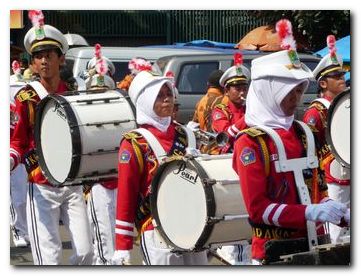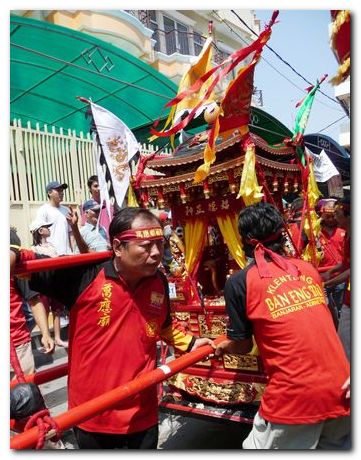A temple procession brings Chinese culture to life in Jakarta’s streets
Margaret Chan
A god's palanquinMargaret Chan |
On Sunday 18 October 2009, contingents from 33 Chinese temples from all over Java staged what was probably Jakarta’s largest ever Chinese religious festival. Accompanied by musicians, lion and dragon dancers, hundreds of devotees paraded through the streets of Glodok, Jakarta’s Chinatown, carrying 38 images of Chinese deities mounted on palanquins. The procession stretched for more than a kilometre as it wound its way around a ten kilometre circuit in and out of the Glodok district. Three police cars cleared a way for the procession through the city’s perpetual traffic jam.
The focus of the parade was the Fat Cu Kung temple in Glodok itself. No grand place of worship, this little temple’s prayer hall is really just the cramped front room of a private residence at the end of a cul-de-sac off Jalan Kemenangan. By way of enthusiastic celebrations of its deity’s birthday, however, the Fat Cu Kung community punches well above its weight. It started observing the anniversary with a religious procession in 2006, and each year the celebrations have become progressively bigger, yet another sign of the renaissance of Chinese culture in a district that eleven years ago was the scene of violent anti-Chinese riots.
Bringing migrants together
Fat Cu Kung is portrayed as having a black face, staring eyes and a mane of wild black hair reaching to his waist. His cult originates in Fujian province in China, from where it has spread to Taiwan and Southeast Asia. The Chinese have a long history of migration and their success in their adopted lands is largely due to a tradition of mutual help. New migrants are received and resettled within host communities by a network of organisations whose connections extend beyond country borders. Welfare groups, clan associations, trade guilds, schools and hospitals all form part of the network, but the centre of all social activities has always been the community temples. Traditionally, it is on the birthdays of the patron deities that everybody gathers to re-commit to the communal ties that bind them together.
A statue of a deity is the focus of devotion at temples. In addition, each deity is also represented in a number of other typically smaller images, specifically for travel purposes. This can be no more than a short trip within the village, such as when a member of the parish is very ill. In this case, a small image of the deity might be brought to the patient’s house to ensure that the sick person gets the full attention of the god.
Chinese gods enjoy outings so devotees dress their images in travelling clothes and take them on journeys, even moving them to new homelands
Chinese gods enjoy outings so devotees dress their images in travelling clothes and take them on journeys, even moving them to new homelands. This is why the main statues in temples of the Chinese diaspora are often small – they are the original diminutive images brought from the ancestral village.
The images of the gods embody the cult, but ash from the container in which incense is burnt – called a censer – is also important. When a branch temple is set up, ash from the main censer of the mother temple must be collected and brought to the branch location. This is the ritual of fenxiang, which translates as ‘dividing the incense’. At a temple festival, the gods on parade form the main spectacle. But it is the less ostentatious ceremony of fenxiang that is socially binding. Dividing of incense ash represents a commitment to a shared identity and destiny, and it is this spirit of solidarity that joins Chinese around the world.
When representatives from the 33 temples from all over Java gathered at the Fat Cu Kung temple in Glodok, each party brought along a small censer of incense ash. Placed together on a common altar table, the collection of censers represent the communal bonds that join the temples in a mutual help network. Bringing together such widely-dispersed temple communities, the Fat Cu Kung celebrations represented an important event in Indonesian-Chinese communal relationships. According to several people I spoke to at the parade, the celebration was the grandest Chinese religious festival Jakarta had seen since the start of reformasi.
All the excitement of a parade
A frisson of anticipation shot through the crowd when a large drum was struck at 1pm to mark the start of the parade. Several bands of musicians immediately took up the cue. Cymbals clashed and gamelan gongs were beaten as the palanquins were lifted onto shoulders. These palanquins had been trucked into Glodok from places like Jepara, Losarai Brebes, Semarang, Tegal and Cilacap in Central Java; Bogor, Kerawang and Purwakarta in West Java; and Pamekasan Madura, East Java. Some of them were as large as the cab of the ubiquitous scooter-taxis (bajaj) of Jakarta. The Indonesian word for these heavy chairs is joli, and the English word ‘jolly’ describes the exuberance that permeated the Fat Cu Kung celebrations.
 |
Muslim students join the marchMargaret Chan |
In the euphoria of the moment the devotees swung the palanquins onto their shoulders, ignoring the pain of the carrying shafts cutting into their flesh. Caught in the excitement of it all I impulsively leapt onto a friend’s motorcycle. We zig-zagged between cars and rode up and down pavements, following the procession part of the way and then we cut through backstreets to outflank them and get to a vantage point where we stopped to let the parade pass by. The route began at the Fat Cu Kung temple on Jalan Kemenangan in the Patekwan district, leading on to Jalan Pintu Kecil, Jalan Kali Besar Barat, Jalan Kali Besar Timur 3, around Fatahillah Museum Square, Jalan Lodan, and past Plaza Glodok on Jalan Hayam Wuruk, Jalan Mangga Besar. It then made a U-turn to head back up Jalan Mangga Besar to Jalan Gajah Mada before returning to Jalan Kemenangan.
Religious differences set aside
Watching the parade, I was struck by the sight of marching bands of Muslim students and a contingent of dragon dancers from the Indonesian armed forces at the head of the column. Right after the vanguard of police cars, came the Guntur Naga Geni, a dragon dance troupe from the Yon Armed-11 Kostrad, a land artillery battalion of the Indonesian Army’s Strategic Reserve. Earlier, I had chatted with the soldiers while we waited for the start of the parade in the main hall of the Ricci Catholic School on Jalan Kemenangan. As they tucked into their specially-catered halal meal of curry and rice, I ate noodles prepared by volunteers of the Fat Cu Kung temple. These macho men and their twin dragons were followed by three marching bands of high school youths. Two groups played on brass instruments and drums while the third comprised a band of girls wearing headscarfs and twirling large flags. I heard that they came from Islamic schools in Kerawang, just west of Jakarta.
Right after the vanguard of police cars, came the Guntur Naga Geni, a dragon dance troupe from the Yon Armed-11 Kostrad
The military dragon dance team and the school marching bands were paid a fee for taking part in the Fat Cu Kung parade. It was a pragmatic arrangement, strictly commercial and entirely devoid of religious involvement. Such a matter-of-fact attitude is also evident among the troupes that regularly prowl the lanes of Glodok, going from shop to shop to perform the Chinese lion dance. Most of them are made up of non-Chinese youths, many of whom must be Muslim. But religion does not come into the picture. If the Chinese will pay for perfunctory performances of lion dance at their place of business, then the youths see no problem in quite literally dancing to that tune.
Such pragmatic arrangements are not out of place in Indonesia. Indeed, they offer an opportunity for different communities to come together in peaceful solidarity in a society where ethnic and religious connections are still being re-negotiated. People can get together for all sorts of reasons. It does not matter if the objectives are lofty or prosaic. The important thing is that they do get together.
Margaret Chan (margaretchan@smu.edu.sg) is Practice Assistant Professor of Theatre/Performance Studies, School Social Sciences, Singapore Management University.












